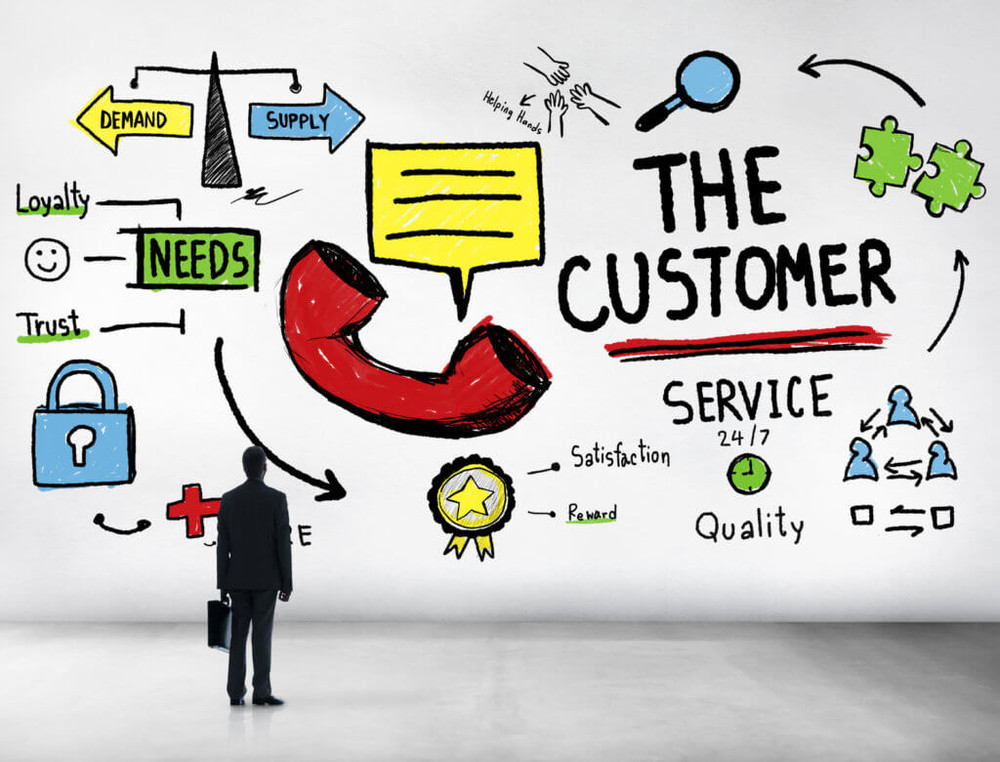10 Customer Services Skills Your Auto Repair Shop Needs
Posted by Juan E. Chavez on 31st May 2019
You might think you sell parts and labor. You’d be wrong. What you really sell is customer service—without good customer service, it doesn’t matter if you’re the cheapest, the best, the most convenient—whatever qualifier you want to use—you will lose business to a shop with superior customer service.

Customer service is what drives businesses—almost all businesses, but especially a business like an auto repair shop. Good customer service keeps customers coming back, attracts new customers, and allows a business to grow, year after year. Bad customer service does the opposite—in a study conducted by Harris Interactive, a market research firm, they found that 89% of consumers have switched to doing business with a competitor following a poor customer service experience.
Where does that leave your shop? One of the best marketing tips you could get is to put customer service first. You want to be the business that customers switch to. One way to do that is to provide superior customer service—consistently, to every customer possible. If you do that, the word of mouth referrals you get will win you new customers. And every new customer you get is a customer someone else has lost. Do you really want to crush your competitors? Here’s how to do it: with these ten essential customer service skills.
#1: Expert Working Knowledge
When every employee in your shop has expert knowledge of the kinds of repairs and procedures customers are likely to inquire about, it instills in them a sense of confidence that shines through in every interaction. When someone can answer a cold question from a customer without missing a beat, it instills confidence in that customer, as well—your employee, and everyone in your shop, look like rockstars who really know their stuff.

It also leads to faster resolution of customer problems, no need for an employee to check with another staff member for an answer, clear communication of what the customer’s facing and what the likely solution would be, better recommendations for goods and services, and—most importantly—interactions that come across as effortlessly confident.
Of course, many problems can’t be diagnosed over the phone. If a customer calls and says “It’s making a rrr-rrr-rrr sound when I make left turns,” that could be a number of things, but if an employee is able to respond, confidently, “Well, that could be a cracked CV boot or a worn ball joint, but when you bring it in we’ll be able to tell you exactly what it is,” that lets the customer know that they’ve made the right choice in calling your shop. Whatever the problem might be, having employees with expert-level familiarity with all but the most esoteric repair issues gives a great impression to customers—current or new.
#2: Make the Extra Effort
Outstanding customer service isn’t just about being friendly and solving problems. Truly great customer service involves making extra efforts and “going the extra mile” to ensure customers are not only satisfied with the level of service they’re getting—they’re genuinely pleased. Little things like topping off a customer’s coolant or oil level, or inflating their tires to the appropriate pressure if they’re in for something as routine as tire rotation is the kind of thing that, while it might cost your shop pennies, builds a reputation for taking excellent care of every customer’s vehicle, and even providing small services that weren’t expected—or billed for. Do be sure to let the customer know when you do those little things, as it only counts if they know about it. And be sure to end every interaction with something as simple as, “We really appreciate your business—is the anything else we can do for you?”
#3: Take Your Time, Keep Your Cool
Some customers are going to try your patience. They’ll expect unreasonable things, demand a repair job that takes three hours be done in fifteen minutes, or expect their job to be put ahead of every other ticket your shop is working that day—just because. It’s important to be patient, even with these customers, as you never know what kind of day they might be having or what the ultimate reason might be behind their unfair, unrealistic expectations.
It’s not always easy to be patient, but (as with anything) practice makes perfect. The ability to slow down, listen to everything a customer has to say, and then respond in a cool, collected, even friendly manner is a hallmark of excellent customer service. The impatient customer may not notice it right away, but after they’ve had a chance to cool off, they might think, “I was a jerk to that really nice person at the auto shop, and they responded in such a nice way,” and that will leave an impression. And if you run a busy shop and have a couple of customers standing by, they’ll notice the way a less-than-reasonable customer is handled, and that, too, will be noticed.

You might have customers who will lose their cool, frustrated at the expense or the time a repair might take—which may be completely out of your hands. They may not understand what the problem with their vehicle is, or get why a certain (perhaps costly, time-intensive) repair is the only solution, and they might take their frustration out on you. Maybe they’re just in a hell of a hurry (and really, who isn’t, these days?) and want the problem fixed—yesterday.
It helps to remember that in every interaction, you’re the ambassador of your shop, and the face of customer service. You have to let that customer’s frustration or bad attitude just slide off of you, and respond to them in a positive, friendly, and above all patient manner. Treat them as if they were a model customer, and you might be surprised at the change it makes in their demeanor.
#4: Know How to Handle Surprise Situations
Something will happen from time to time that will surprise you. Things won’t go as planned, a repair your shop just did will fail for some unusual (and uncontrollable) reason, or you’ll get a problem vehicle in with an issue you can’t diagnose—let alone repair.

It’s important to know how to handle these curveball situations. You need to be able to quickly and competently respond to a surprise—especially an unpleasant one—in a way that shows the customer that you’re able to handle whatever it is that’s popped up. When this kind of thing happens in your shop, it’s good to know what steps to take to solve the problem—while still being able to look like you’ve got it all together.
If the solution involves checking with the shop owner or the resident expert on whatever the problem is, let your customer know you’re going to get right on solving whatever oddball problem has popped up, and tell them you’ll get right back to them. Always make sure you can go to whoever the resource is for whatever strange problem might present itself, and the best way to do that is to identify ahead of time who that person is. Is it the shop owner? The resident transmission expert? Or even a rep at a parts vendor who might be able to diagnose why a brand-new part failed an hour after it drove out of your shop? Get those people involved as quickly as possible, and get back to the customer with whatever progress you’ve managed to make as soon as it makes sense. “I’m working on taking care of that for you, and have talked to X, Y, or Z about this specific problem—they’re getting back to me with an answer and as soon as I have one, we’ll go from there.” And stress this: “But I do want you to know that I’m working on this proactively, and we’ll figure out what the problem is and get it taken care of for you.”
#5: Be Clear and Concise in Communication

Your customer’s time—and yours—is valuable. It pays to respect that, and when communicating with a customer, don’t make them wait on hold, don’t shuffle papers while you’re looking for their work order or repair ticket. Have a system in place so you can quickly pull up the information you need—and always have it ready before you call them or return a call. Get back to customers as quickly as possible, and when you’re talking to them, get right to the point, be as clear as you possibly can, and don’t take more time than necessary to communicate the essentials.
That doesn’t mean be rude—let the customer set the pace of the call, but when you’re providing information, do it professionally, courteously, and in a way that indicates you value their time. If they’re friendly and laid back, respond in the same way. If they seem like they’re in a hurry, let them know what to expect, ask any questions you need the answers to, and then let them get on with their day.
#6: Follow Through
This follows right on the heels of our previous tip. When setting expectations for follow-up, let the customer know when you’ll be calling, what information you’ll have when you call, and ask them if there are any other questions they’d like answered at that time.
Call when you say you will, even if there’s a problem that hasn’t been resolved yet, and let them know you’re still working on getting whatever the situation may be addressed. It helps to be conversational, and address your customer by name. Listen to what they have to say and be sure you understand their expectations before ending communications.
#8: Deal with Problems in a Calm, Collected Way
Remember tip #3? This one is similar, but with a twist. No one’s perfect—not even you. So when there’s a problem—and it’s on you—admit it, address what steps you’re taking to solve it, and above all else: stay calm. You’ll have situations where customers are not happy, and have every reason to feel that way. Acknowledge it—in a calm, measured tone of voice. Don’t take it personally, even if the customer gets irate. Let them vent, apologize if you’re in the wrong (and really, even if you’re not), and listen to everything they have to say without cutting them off and without deflecting their concerns. Never argue with a customer, make an effort to understand their frustration, and let them know you get it—“You’re right, I’d be upset, too.” Show that you’re sympathetic to their situation, be sincere, and assure them you’ll do everything you can to solve the problem—calmly.
#9: Spot Customer Service Problems Before They Happen

There are going to be times when a customer’s going to get hit with an estimate that’s a lot higher than the ballpark figure you might have given them, or when a needed part is on backorder and won’t arrive for a week—keeping their vehicle tied up and inconveniencing them. If you’ve run an auto shop for any length of time, you’ll be able to fill in a few more blanks here. The point is: there will occasionally be problems.
The key to handling these it to let the customer know what caused the problem, or what factors come into play. Don’t condescend to them, never talk down to them, and (again) never argue with a customer. Let them know what you can do to try to remedy the problem as soon as possible, listen to their concerns, and let them talk. The key here is to be prepared, to spot the problem before it happens, and have a plan in place before you contact them. Have a game plan, and stick to it.
#10: Wrapping it Up
At the end of every customer interaction, you have an opportunity to make one more impression . When you’re wrapping up communication—whether it’s on the phone, in person, or even in something like email—you want your customer to feel like all of their questions—and any objections they may have stated—have been addressed and taken care of. You never want to leave a customer feeling like they have a concern that hasn’t been acknowledged.
This can be as simple as always asking “did I answer all your questions?” or “is there anything else I can help you with?” at the end of every call. You want your customer to know you care about their experience. Let them decide when the interaction is over—never be in too much of a rush that you can’t answer a question, and never cut a customer off while they’re talking. Taking a few extra minutes to show you’re they’re to help a customer will leave them with a good feeling—which is right where you want them to be.
Make these ten customer service skills mandatory for how you and your employees interact with customers. Train new hires—and existing personnel—in them, and in how to handle the different situations that may arise. If you make outstanding customer service a priority, you’ll keep your existing customers (and build their loyalty), gain new ones, and watch your business grow.

